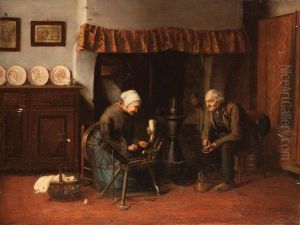Alfred Desplanques Paintings
Alfred Desplanques was a French painter born on February 18, 1853, in Douai, a commune in the Nord department in northern France. He was primarily known for his portrait paintings and genre scenes that vividly captured aspects of French life during his time. Desplanques studied art at the École des Beaux-Arts in Paris, where he was a student of the renowned academic painters Alexandre Cabanel and Adolphe Yvon.
Desplanques's work was characterized by a traditional academic style, reflecting the influence of his teachers and the artistic conventions of the late 19th century. He exhibited at the Paris Salon, the official art exhibition of the Académie des Beaux-Arts in Paris, which was the primary showcase for French artists to display their work. The Salon was the most prestigious art event in France and played a significant role in shaping the tastes and judgments of the French public and art critics.
Throughout his career, Desplanques earned accolades for his finely detailed and meticulously painted works. His portraits often depicted individuals in their everyday surroundings, offering a glimpse into the private lives of his subjects. He also painted religious subjects and scenes from history, displaying a versatility and breadth in subject matter.
Although Alfred Desplanques' name might not be as widely recognized as some of his contemporaries, his contributions to French art during the Belle Époque—a period characterized by optimism, regional peace, economic prosperity, and technological, scientific, and cultural innovations—were appreciated during his lifetime. His paintings are a testament to the academic art tradition that dominated France prior to the emergence of Impressionism and other modernist movements.
Desplanques' work can be found in various museums and collections in France, providing an important historical record of the period and style he represented. His paintings continue to be admired for their classical beauty, attention to detail, and the artist's technical skill.
Alfred Desplanques passed away on February 19, 1913, in Paris, at the age of 60. His legacy is preserved through his artistic contributions and the works he left behind, which continue to be studied and appreciated by art historians and enthusiasts of French academic art.
